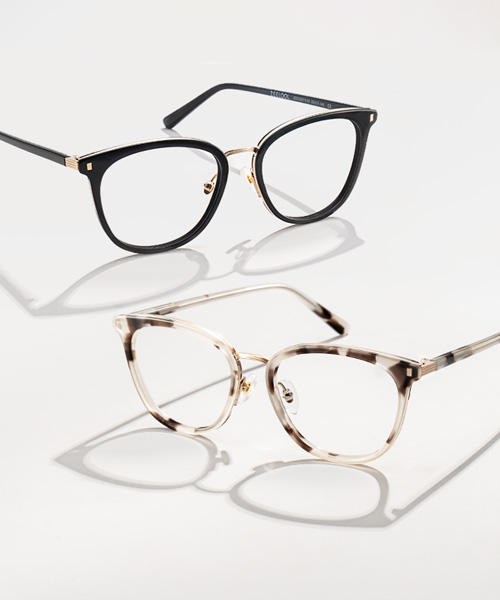Selecting the right eyeglass lenses is essential for achieving optimal vision, comfort, and eye protection. With over 75% of adults worldwide using some vision correction, understanding the different eyeglass lenses available can significantly improve your eyewear experience. Eyeglass lenses are not one-size-fits-all; they vary in function, material, and style, each designed for specific needs.

This guide explores the most popular type of eyeglass lenses, helping you choose the perfect option based on your lifestyle, prescription, and personal preferences.
Understanding Eyeglass Lenses: Why They Matter
Eyeglass lenses do more than correct your vision. They affect your eye health, daily comfort, and how you see the world. The global eyewear market is projected to reach $151.37 billion by 2025, reflecting the growing demand for specialized lenses beyond basic vision correction.
Key Considerations When Choosing Eyeglass Lenses:
● Prescription Strength: Distance, reading, or multifocal needs
● Lifestyle Factors: Screen time, outdoor activities, or fashion preferences
● Lens Features: Thickness, weight, coatings (anti-reflective, scratch-resistant)
Types of Eyeglass Lenses
To make the best choice, it's crucial to understand the available options. Here's a breakdown of the different type of eyeglass lenses and how they cater to various vision needs:

Single Vision Lenses: The Everyday Essential
Single-vision lenses represent seventy percent of prescription lens purchases today.
Single-vision lenses are the primary form of corrective lenses, delivering constant prescription power across their entire surface. They function as a universal correction for myopia, which means nearsightedness, or the opposing vision condition known as hyperopia.
Why Choose Single Vision Lenses?
Single-vision lenses are perfect for daily tasks like reading or driving.
● Lightweight and budget-friendly
● Single vision lenses allow customization with anti-reflective, anti-scratch, and blue light filtering protective elements.

Bifocal Lenses: Dual Function in One Frame
Did You Know? The natural decline of eye focus from aging results in demand for bifocal eyeglasses among 45% or more people aged 45 years and above.
Bifocal lenses divide their surface into upper and lower parts, which serve as areas for distance and near vision, respectively.
Advantages of Bifocal Lenses:
● Combines two prescriptions in one lens
● One pair of glasses is enough since you don’t have to switch between different pairs.
● Ideal for reading and computer work

Progressive Lenses: Seamless Vision at All Distances
Market research indicates progressive lenses will expand at a 4.8% annual growth rate until 2030 because consumers search for fluid vision solutions.
The progressive lens incorporates a smooth prescription transition between distance vision, intermediate vision, and near vision without creating visible lines, as in bifocals.
Benefits of Progressive Lenses:
● Ideal for people with presbyopia
● These lenses have no visible lines, giving you a cleaner and more modern look.
These lenses provide the ideal choice for people who perform multiple tasks while needing to see everywhere.
Photochromic Lenses: Adaptive Vision Indoors and Outdoors
Ten million Americans use photochromic lenses throughout the United States because they offer protection from UV rays and convenience.
Photochromic lenses darken in sunlight and turn clear again indoors.
Why Choose Photochromic Lenses?
● Blocks 100% of UVA and UVB rays
● The same lenses protect both photochromic lenses and sunglasses combined.
The transition between bright and dim environments results in decreased eye strain because of these photochromatic lenses.

Polarized Lenses
Polarized lenses reduce glare and improve clarity, especially in bright sunlight.
Did You Know? Driving conditions become hazardous when glare reduces visibility to sixty percent, leading to increased accidents.
Outdoor enthusiasts and drivers greatly benefit from polarized lenses because they minimize glare reflections from road surfaces and reflective water elements.
Key Features of Polarized Lenses:
● Enhances clarity and contrast
● Reduces glare for safer driving
The combination works excellently for sports, fishing, and boat excursions.

High Index Lenses: Lightweight Comfort for Strong Prescriptions
High-index lenses maintain their lightness because they reduce thickness by approximately half compared to typical plastic lenses, which benefits people who need potent prescriptions.
High-index lenses are ideal for strong prescriptions because they stay thin and work with any frame style.
Advantages of High Index Lenses:
● Thinner, lighter, and more comfortable
● Compatible with stylish, rimless frames
● HV protection features, together with scratch resistance, function as standard components.
Tinted Lenses: Style with Functionality
People use tinted lenses for appearance enhancement along with functional advantages through specific lens color choices.

How to Choose the Right Eyeglass Lenses: 5 Key Factors
The selection process of eyeglass lenses requires an evaluation beyond medical prescriptions. Consider these five essential factors:
1. Prescription Strength:
Vigorous prescriptions benefit best from using high-index lenses. These lenses combine thinness with lightness, eliminating the weight and heaviness of conventional prescription eyeglass lenses.
2. Lifestyle Needs:
People who spend time in bright outdoor conditions should use polarized lenses since these lenses cut down glare to provide better visibility. People transitioning between inside and outside can use photochromic lenses that adjust their opacity according to changing light conditions.
3. Aesthetic Preferences:
Progressive lenses provide a smooth appearance because they lack visible borders, and tinted lenses combine fashion and function, adding color while improving vision in different conditions.
4. Eye Protection:
The combination of polarized and photochromic lenses functions as essential UV blockers to protect your eyes from dangerous radiation.

5. Comfort and Weight:
People with high prescriptions should opt for lightweight, high-index lenses because they provide better all-day comfort with these stronger prescriptions.
Considering these factors helps you choose lenses that fit your vision needs and lifestyle.
Conclusion
Choosing which eyeglass lenses to select creates a significant enhancement of your vision quality and a positive influence on your daily routine. Each type of eyeglass lenses exists for its distinct function between single vision daily use lenses and progressive lenses, providing step-less transitions between vision ranges. Photochromic lenses, which adjust to light levels, shield your eyes from UV rays, while polarized lenses reduce glare to perfect your eyewear experience.
ZEELOOL is an excellent choice for finding different types of lenses for glasses that combine style and function with comfort.




























